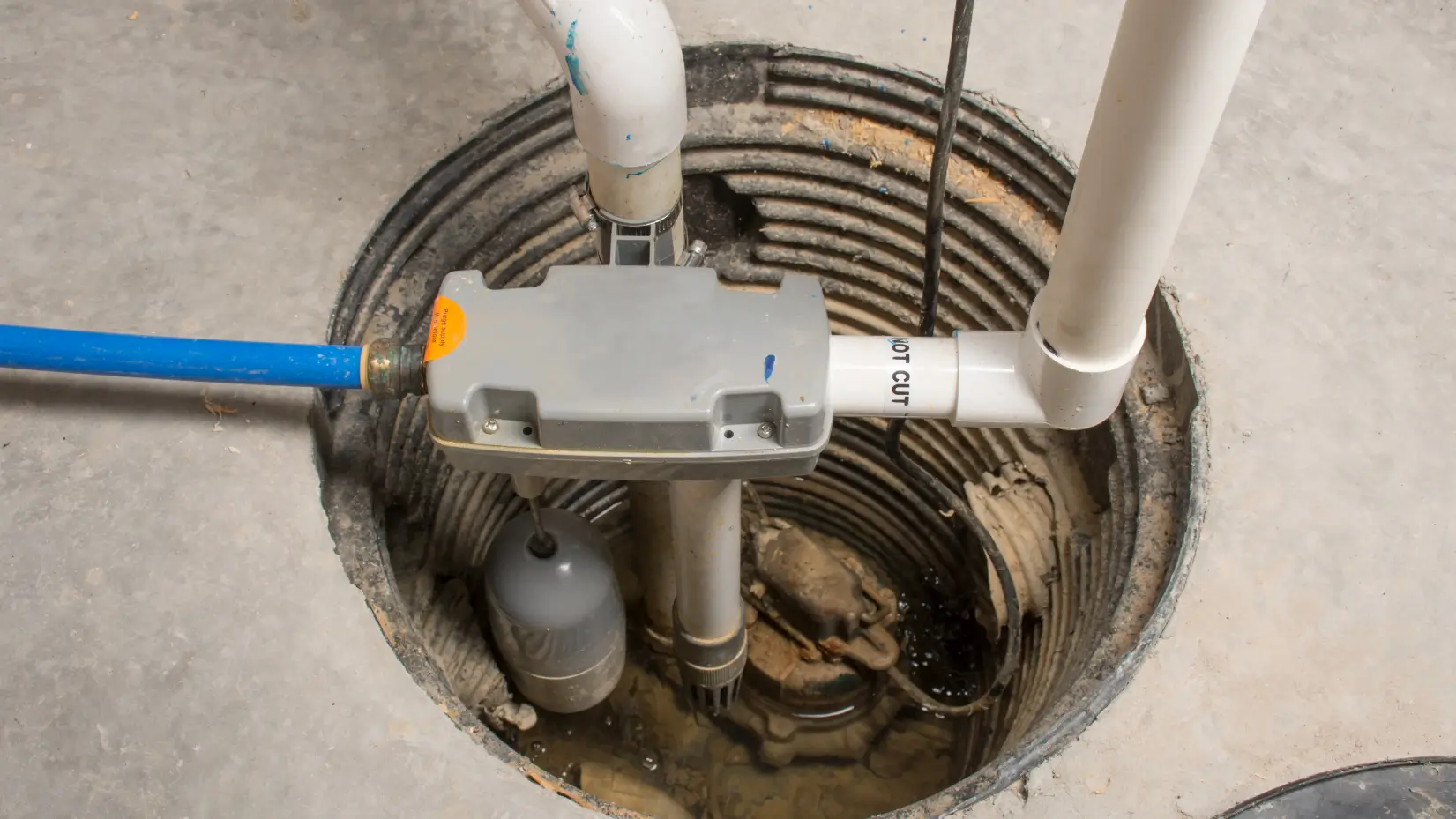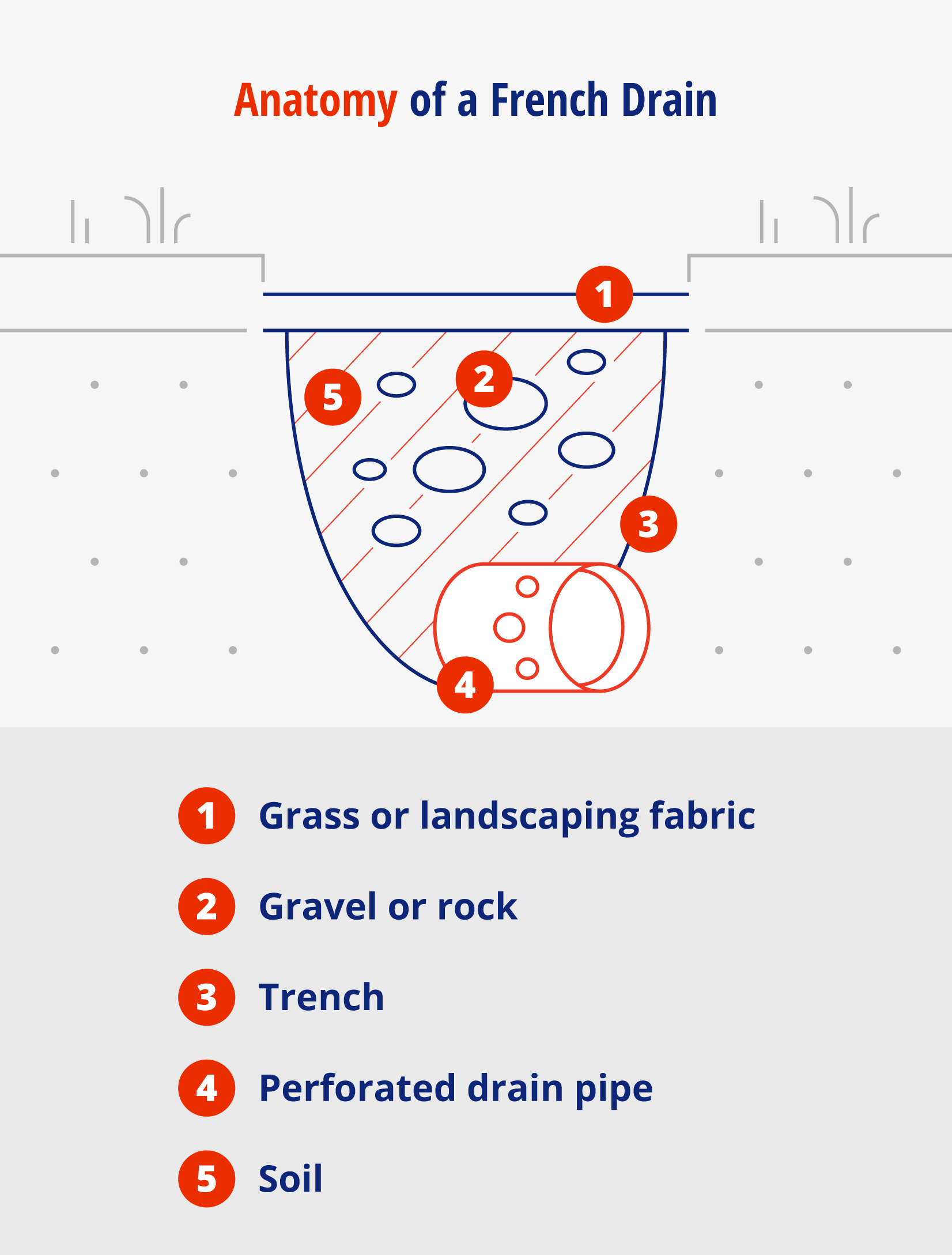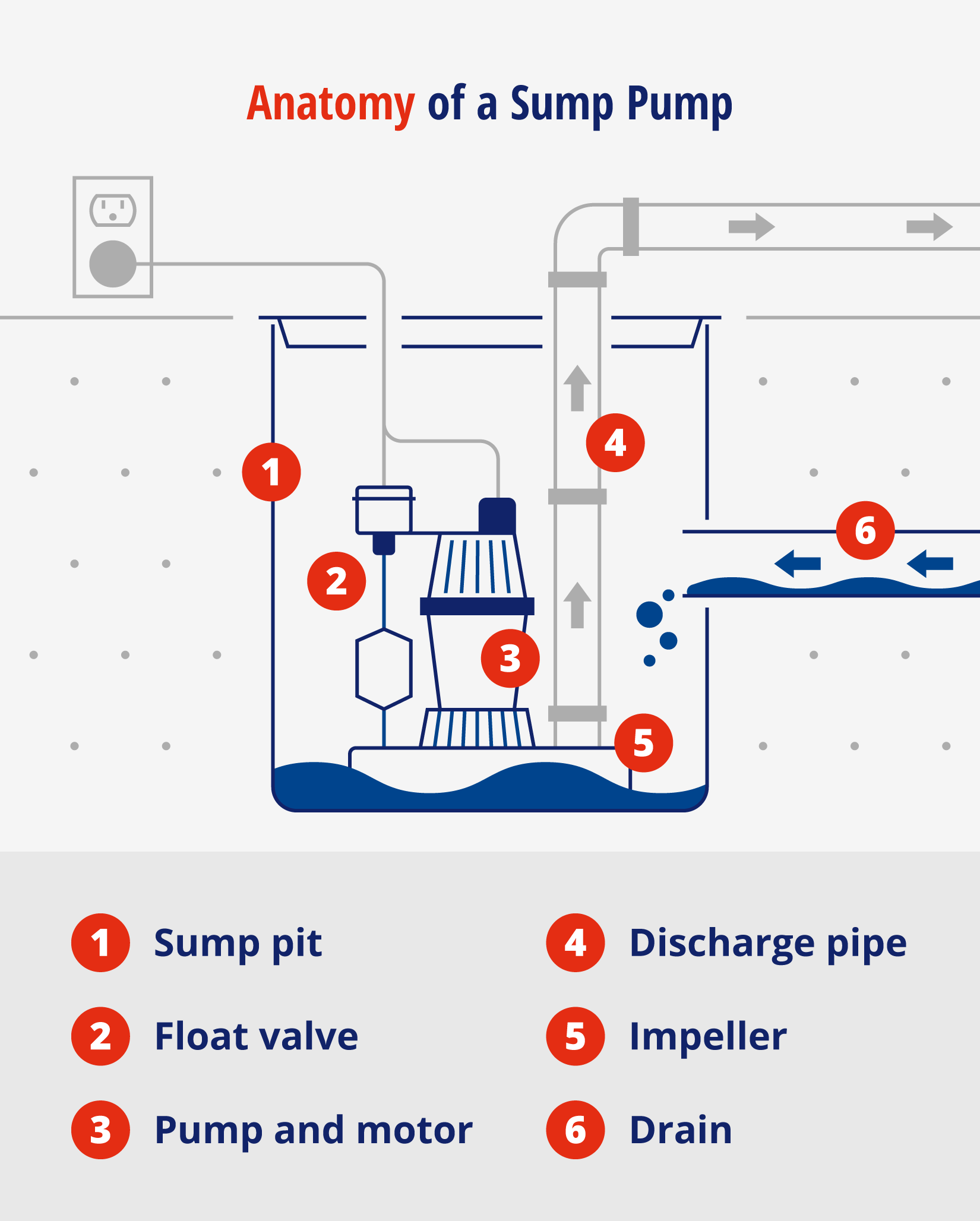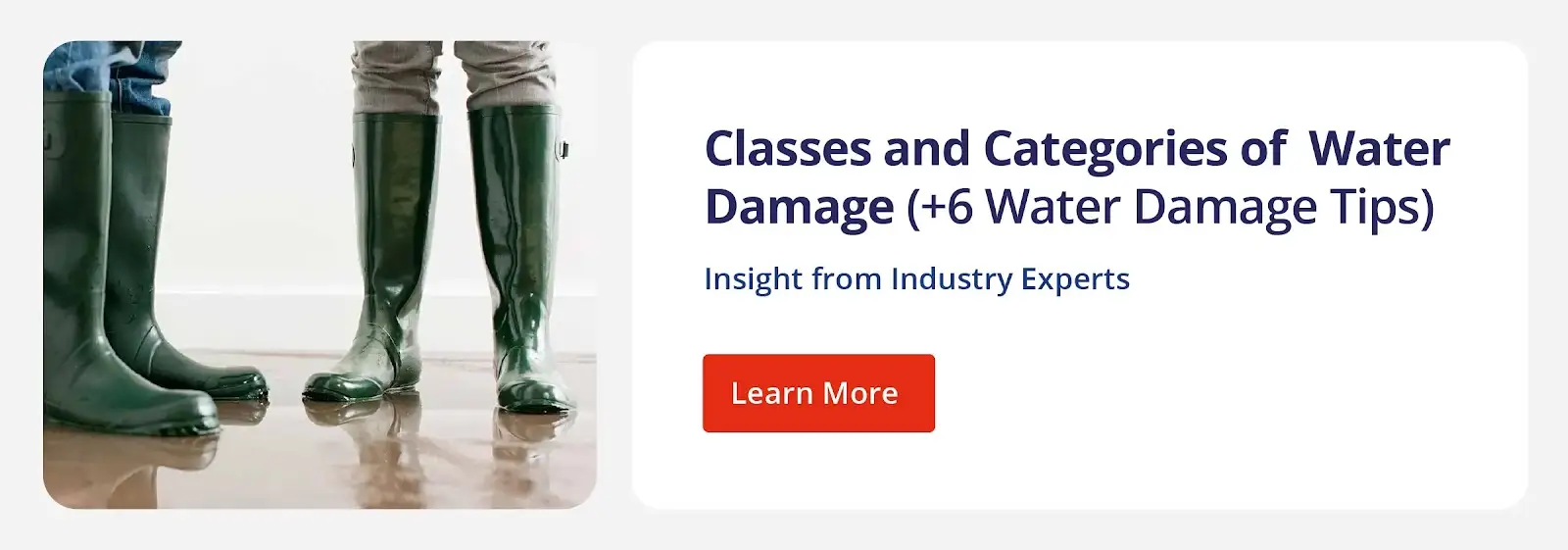
Rainbow Restoration explains the key differences between French drains and sump pumps for managing water in basements and yards.
|
|
A French drain redirects water away from a property using a pipe and gravel, while a sump pump actively removes water from a pit and pumps it away from the foundation to prevent flooding. |
Water doesn’t knock before it floods a property — it barges right in. And the aftermath of floods can be overwhelming. Wet carpets and cushions can take days to dry, and delays in addressing water intrusion can lead to mold growth, structural damage, and costly repairs.
The best defense against water damage from floods is an effective waterproofing solution. French drains and sump pumps are two popular methods, but how do they stack up? Draw a thorough French drain vs. sump pump comparison, and learn about their functionality, cost, and benefits to find the best option.
Table of contents:
- What Is a French Drain System?
- What Is a Sump Pump?
- Differences Between a French Drain vs. Sump Pump
- Is It a Good Idea To Combine a French Drain and Sump Pump?
- Trust Rainbow Restoration® for Water Damage Restoration
- French Drain vs. Sump Pump FAQ
What Is a French Drain System?
A French drain is a sloped trench filled with gravel or rock containing a perforated pipe that redirects water away from vulnerable areas. But what does a French drain do exactly? Typically installed along the perimeter of a building or in a basement, it collects and channels groundwater or rainwater away from the foundation, helping prevent floor water damage.
The collected water flows downhill to a designated exit point such as a street gutter, a gravel pit, or even a sump pump if the systems are connected.
Most suitable for:
- Properties prone to standing water near foundations
- Buildings experiencing frequent flooding in basements or low-lying areas
|
Advantages |
Disadvantages |
|
Low maintenance |
High initial cost |
|
Energy efficient |
Intensive installation |
|
Hidden appearance |
Requires excavation |

Advantages
French drains offer several benefits, particularly for commercial properties that require effective yet low-maintenance solutions to water intrusion problems. Benefits include:
- Low maintenance: A French drain operates passively once installed, requiring minimal upkeep.
- Energy efficiency: French drains don’t rely on electricity to divert water, making them a cost-effective and eco-friendly solution for long-term use.
- Hidden appearance: French drains are discreet, with the system buried underground.
Disadvantages
While French drains are effective, installation and costs can pose challenges, including:
- High initial cost: The upfront expense of materials, labor, and excavation can be significant, especially for large properties.
- Intensive installation: Installing a French drain requires skilled professionals and may involve digging up landscaping or flooring, which can disrupt business operations.
- Requires excavation: Because the system is installed underground, excavation can be invasive and time-consuming, especially for existing structures.
What Is a Sump Pump?
A sump pump is an electrical device that removes water collected in a sump basin, typically located in the lowest part of a basement or crawl space. For yard drainage, sump pumps are often used as a proactive measure to prevent pooling water from infiltrating the foundation. Additionally, sump pumps can help after floods by effectively managing large volumes of water and protecting properties from extensive damage.
The water pumped out is directed away from the property through a discharge pipe, typically leading to a designated drainage area such as a storm drain or dry well.
Most suitable for:
- Buildings with basements prone to flooding
- Areas with high water tables requiring active water removal to prevent damage
|
Advantages |
Disadvantages |
|
Relatively low cost |
Requires electricity |
|
Easy installation |
Requires regular maintenance |
|
May be noisy |

Advantages
Sump pumps are a practical solution for properties that need active water removal. They are a popular choice for commercial spaces and homes because of their:
- Relatively low cost: Sump pumps are an affordable option for waterproofing, with lower initial costs compared to alternatives like French drains.
- Easy installation: The installation process is straightforward, especially in new constructions or basements designed to accommodate a sump basin.
Disadvantages
Despite their benefits, sump pumps have limitations that should be considered before installation:
- Requires electricity: Sump pumps rely on electricity to function, meaning power outages during storms can render them ineffective unless paired with a backup system.
- Requires regular maintenance: To ensure reliability, the pump and its components must be inspected and cleaned periodically.
- May be noisy: The pump’s operation can be loud, which might be disruptive in quiet work environments or spaces where noise control is essential.
Differences Between a French Drain vs. Sump Pump
When deciding between a French drain and a sump pump, understanding their key differences can help property owners make an informed choice. While both systems manage water effectively, they differ in cost, installation complexity, and functionality.
1. Cost
Best: Sump pump
The cost to install a sump pump averages between $500 and $1,500, depending on the pump type and complexity. Standard pumps are on the lower end, while advanced models with backup power options are more expensive.
In comparison, the cost to install a French drain ranges from $5,000 to $15,000 or more for a comprehensive system. This higher price reflects the extensive excavation and labor involved, as well as the materials required. While a French drain is a long-term investment with minimal ongoing expenses, its initial cost makes it less budget-friendly than a sump pump.
2. Installation
Best: Sump pump
Installing a sump pump typically involves digging a sump basin, placing the pump, and connecting it to a drainage pipe that directs water away from the property. This process is relatively quick and less invasive, making sump pumps a convenient choice, especially for addressing backyard flooding or adding active drainage to existing spaces.
In contrast, installing a French drain requires excavating a trench around the building's foundation or in problem areas, lining it with gravel, and placing a perforated pipe before covering it back up. This extensive work can disrupt landscaping and require significant labor.
3. Location
Best: French drain
French drains are designed to be discreet, with their primary components buried underground. They are typically installed along the perimeter of a building’s foundation or in areas prone to water pooling. This hidden design preserves properties' aesthetic appeal while effectively redirecting water away to prevent various types of water damage, like basement leaks or soil erosion.
Sump pumps are usually located inside the building, within a basement or crawl space. While effective, their presence is more noticeable due to the sump basin and associated piping. This makes them less ideal for spaces where aesthetics are a priority.
4. Drainage capability
Best: Sump pump
Designed to actively remove water, sump pumps are ideal for situations like severe flooding or persistent issues with water pooling. A sump pump for backyard flooding is particularly effective, as it can rapidly redirect water to a safer location away from the property.
While French drains excel at passive water management, they are better suited for steady groundwater drainage or preventing gradual seepage near foundations. They rely on gravity and cannot handle sudden surges of water as efficiently as a sump pump.
5. Reliability and maintenance
Best: French drain
For consistent, long-term reliability, French drains take the lead. As a passive system, they function without the need for electricity or moving parts, making them less prone to failure. This makes them an excellent choice for properties where maintenance might be infrequent, such as rental properties prone to flooding. Once properly installed, a French drain requires little upkeep beyond occasional checks to ensure the pipe is free of debris.
While effective, sump pumps depend on electrical power to operate, making them vulnerable during outages. Backup systems, like battery- or water-powered pumps, can mitigate this issue but add to the overall cost and maintenance. Additionally, regular inspections and servicing are essential to ensure the pump operates correctly when needed.
6. Lifespan
Best: French drain
French drains generally have a longer lifespan than sump pumps. With proper installation and minimal maintenance, a French drain can last for decades — often 30 years or more. Since the system has no moving parts, it isn’t subject to wear and tear like a sump pump, making it a reliable and long-lasting solution for managing rental property floods or water drainage.
Sump pumps, on the other hand, have a much shorter lifespan. On average, a sump pump lasts about 10 years, though with proper maintenance, it could last up to 15 years. The pump's mechanical components and reliance on electricity make it more susceptible to wear and potential failure over time.
For properties considering alternatives to sump pump systems, French drains provide a more permanent and low-maintenance solution.
Is It a Good Idea To Combine a French Drain and Sump Pump?
In many situations, combining a French drain and a sump pump can offer optimal protection against water damage. While a French drain without a sump pump is ideal for redirecting groundwater and preventing minor water intrusion, a sump pump can actively remove water during a flood or sudden water surges.
For properties with high water tables, areas prone to rental property floods, or basements below grade level, using both systems ensures comprehensive water management. This dual system is particularly beneficial for properties located in flood-prone regions or those with significant drainage issues. French drains handle continuous, passive water flow, while sump pumps quickly handle sudden inflows or rainwater buildup.
Choosing a sump pump without a French drain or vice versa depends on the severity of the water issues at hand, and combining the two may provide the best of both worlds for long-term protection for some properties.
Trust Rainbow Restoration for Water Damage Restoration
When it comes to protecting properties from water damage, understanding the pros and cons of a French drain vs. sump pump is essential for making an informed decision. While these pipes can help to an extent, water mitigation and water damage restoration services might still be needed, especially after natural disasters like floods.
Call Rainbow Restoration for expert residential and commercial restoration services to mitigate water and mold damage.
This article is intended for general informational purposes only and may not be applicable to every situation. You are responsible for determining the proper course of action for your home and property. Rainbow Restoration is not responsible for any damages that occur as a result of this blog content or your actions. For the most accurate guidance, contact the Rainbow Restoration location nearest you for a comprehensive, on-site assessment.
French Drain vs. Sump Pump FAQ
Setting the highest standards in water, fire, and mold damage restoration requires a continuous focus and dedication to education and improvement. This commitment to exceptional service also includes using our years of experience and expertise to answer your restoration questions.
Here are answers to some of the most frequently asked questions about French drains and sump pumps.
Will a sump pump work without a French drain?
Yes, a sump pump can work without a French drain. However, it may be less efficient, as a sump pump typically requires a way to collect water, and a French drain helps direct water toward the sump pump. Without a French drain, the sump pump may need to handle water from a larger area or rely on other drainage methods.
How deep is a French drain?
A French drain is usually 18 to 24 inches deep, depending on the level of water intrusion and the area where it’s installed. The trench should also be wide enough to accommodate the perforated pipe and gravel, allowing water to flow through efficiently.
How close should a French drain be to the house?
A French drain should be installed at least 3 to 6 feet away from the foundation of the house. This distance helps ensure water is directed away from the structure, reducing the risk of foundation damage or basement flooding.
Can I use a French drain for sump pump discharge?
Yes, a French drain can be used for sump pump discharge. It is an ideal method for directing the water pumped out of a sump pit, helping it flow away from the foundation and preventing potential flooding around the house.

